26. ORCHESTRAL SCORES
(Table 26)
[In order to avoid a breach of the rule given in Par. 26.15, the examples in this section are given on pages 251-261. They are labelled 26-1 - 26-9.]
26.1. The method used for the transcription of orchestral scores is "bar-over-bar", as shown in the disposition of open score vocal music (see Example 22.26.2-1).
26.2. There are two types of print scores, the first being that for the conductor in which every page has the complete score even when only one instrument is playing, the second (the miniature or pocket score) in which only those instruments that are actually playing are in general printed on any particular page. It is this latter type of score that is here recommended for the purpose of braille transcriptions.
26.3. The first page of a print score of either type always contains the complete score, regardless of the instruments that may be silent, and the name and (with transposing instruments) key of each instrument is printed before its staff.
26.4. In braille, the names and details of the instruments must be given on a separate page (see specimen on page 251), the first page of the music being devoted only to those instruments that are actually playing.
(a) A list of abbreviations for the English, French, Italian and German names of the usual orchestral instruments is given in Table 26, and in the English edition of the present work the English abbreviations are used in all examples.
(b) It will often be necessary for the transcriber to devise abbreviations for unusual instruments, and these should always be limited to two or three letters conveying an immediate suggestion of the name (e.g. Glockenspiel Glo., Tam-Tam TT, etc.).
(c) It is recommended that the abbreviations used should be those of the language of the country in which the braille score is printed, whatever may be the language of the print score.
26.5. In most print scores the transposing instruments are written in keys other than that of the particular work, and it is therefore necessary to mark the key signature in every line so marked in the print (the horns and trumpets usually have no signature). The key signature follows the abbreviation without an intervening space, thus:
>FL21'% >O21'% >CL21'<<
There is a growing tendency to publish print scores in which all the parts are written in the key of the piece, and in transcribing these it is, of course, not necessary to include key signatures for the separate parts.
26.6. The abbreviation for each part (with its key signature where necessary) must be placed at the beginning of every line in every parallel throughout the score (except in run-over lines (see Par. 26.11)) and in the free lines mentioned in Par. 26.12 and 26.16. The vertically aligned music text should begin as far to the left as the longest instrumental abbreviation (with or without key signature) will permit. In the line with the longest abbreviation, there must be a single space before commencement of the music text, and all other lines of music are vertically aligned accordingly. Run-over lines are indented two spaces from this alignment. Thus, in Example 26-2, page 252 the music text should begin in the seventh space; in Example 26-6, page 256 in the tenth, etc.
26.7. A special octave mark must be given to the first note on every braille line, but the first note of the second and succeeding measures on a line does not need this special octave mark (see Example 26-2, page 252).
26.8. Intervals and in-accords should always be read upward, since the occurrence of treble and bass instruments in irregular order (trumpets below bassoons, etc.) renders any other plan confusing to the reader. In order to further clarify this, each pair of instruments should be written thus: >FL21' etc.
26.9. In "divisi" passages for the strings, it is much better to use in-accords or even separate lines where intervals would have been possible, the only exception to this being passages in octaves. (Examples 26-3 and 26-4, page 254.)
26.10. There is, for typographical and other reasons, considerable variation in the size of parallels in the print miniature score, and the transcriber is not bound to follow the print in every case in this matter if the exigencies of braille warrant a departure from it to secure a more convenient layout. (Example 26-5, page 254.)
26.11. The rule "one part, one line" in each parallel should not be too rigidly followed if it involves a frequent division of the measure, and in parallels in which only a few parts need measure division, run-over lines (indented two further spaces, see Par. 26.6), can be used for the completion of the measure in such parts. (Example 26-6, page 256.)
26.12. Expression marks may sometimes be written together with the music text, but it is generally better to place them on a free line above the part to which they apply. (See Example 26-6, page 256 for both treatments.)
26.12.1. It frequently happens, especially in German scores, that a group of words of expression will occupy too much space when written out in full. Such words are often abbreviated in the print (e.g. "u. ausdrucksv." for "und ausdrucksvoll," or "marc. ed appass." for "marcato ed appassionato"), and it is permissible for the braille transcriber to use similar abbreviations, even when the print directions are given in full. (See Example 26-6, page 256.)
26.13. If such abbreviation is impossible or is insufficient for the purpose, the words may be carried into the next parallel, (dividing a word at the end of the line if necessary) as is sometimes done in print scores (Example 26-7, page 257). (Since these directions will naturally be placed at the point where they occur in the measure, they may appear at any point in the braille line, the limitation mentioned in Par. 28.17 being disregarded.)
26.14. In order to permit the inclusion of a long parallel on one page, the method shown in Example 26-8, page 258 can be used.
26.15. It will be remembered that in Par. 22.34 it is sometimes permitted to relax the rule that a parallel must be completed on the page on which it begins, but the nature of orchestral music is such that clarity demands the strict observance of this rule, whatever the sacrifice in space.
26.15.1. If a parallel contains too many lines for one braille page it can be commenced on a left-hand page and completed on the opposite right-hand page, with an equal number of lines on both pages where possible.
26.16. Where there are two or more parallels on a page, two free lines must be left between parallels, the second of these being reserved for such indications as measure numbers, print page numbers, or reference letters or numbers in the score, etc., and these should be placed in the twelfth or ninth space (see Par. 26.6) as shown in Example 26-9, page 260. The braille convenience of measure-numbering can be used only when there are no numbers or letters in the print.
26.17. All repeats other than those given in the print should be excluded from braille transcriptions of orchestral scores except for very obvious measure or part-measure repeats on the same braille line as the original passage.
26.18. In passages for wind instruments marked "a 2" (or its equivalent in any language) it is customary to re-mark this indication at the beginning of every print parallel while it remains in force, but such repeated marks are not necessary in braille, the numbers attached to the names of the instruments at the beginning of each line being a sufficient reminder to the reader.
26.19. When parts are doubled, either at the unison or octave or double octave, etc., by different instruments, the "parallel-movement" device (Par. 16.29 -16.29.1) may be used. It must include all markings connected with the part of which it forms a copy except expression marks at the commencement of a measure.
26.20. Parallel movement should generally be used for instruments that stand immediately below one another in the score, but for very important and obvious melodic lines doubled by instruments at some distance from one another on the page it can be treated thus:
>V1'< "->FL1'
26.21. The reader is referred to Par. 18.10 for the treatment of expression marks printed during the course of sustained notes, a feature that is often found in orchestral scores.
26.22. It may often be necessary for the transcriber to make adjustments and additions to the foregoing directions and rules, but these must always be based on the principles set forth in this section.
Orchestral Examples
26.23. The following is a specimen of the list of instruments to be given on the page that precedes the music text.
Example 26-1. Specimen List of Instruments
,,DIE ,,MEISTERSINGER ,,VON
,,NURNBERG--,VORSPIEL
KLEINE FL[TE 7PC'74
#B GROSZE FL[TEN 7FL21'7:
#B HOBOEN 7O21'74
#B KLARINETTEN IN ;B 7CL21'74
#B FAGOTTE 7B21'74
#D H[RNER IN ;F 7HN21' HN43'74
#C TROMPETEN3 99
#A U4 #B IN ;F 7TP21'74
#C IN ;C 7TP3'74
#C POSAUNEN 7TB21' TB3'74
BASZTUBA 7BTU'74
PAUKEN IN ;C U4 ;G 7DR'74
TRIANGEL 7TRI'74
BECKEN 7CYM'74
HARFE 7H74
#A VIOLINEN 7V1'74
#B VIOLINEN 7V2'74
BRATICHEN 7VL'74
VIOLONCELLE 7VC'74
KONTRAB>SZE 7DB'74
VIOLONCELLE U3 KONTRAB>SZE 7VB'74
*The trumpet parts are set out in the print approximately thus:
#A U4 #B IN ;F4
#C TROMPETEN4
#C IN ;C4
the top and bottom lines of the above being each placed to the left of its own staff, with the middle line projecting to the left in the space between the staves. The plan shown in the specimen list indicates the best method in all such cases.
(Observe the division of the four horns and the three trombones: this is done to show the number of staves and the number of instruments allotted to each staff.)
Example 26-2.
<#C4
>O1' .?C<$: ?CJCIW ?C<$:<K
>O2' "[C?W [C]] [C?W<K
>O3' "Q] <$CECD: <$?]<K
>B' _SW ?C<$: ?CJCIW<K
>HN1' _]GGGG ]VV ]GGGG<K
>HN2' M _]GGGG ]VV<K
>VPC' .?C<$: ?JCIW ?C<$:<K
>V1' .- .- ''''' .-<K
>V2' "[C?W [C]] [C?W<K
>VL' "Q] 6<$CECD: <$?]<K
>VC' _SW ?C<$: ?CJCIW<K
>DBC' _- "- ''''' "-<K
VPC' = Violino piccolo
DBC' = Double bass and cembalo
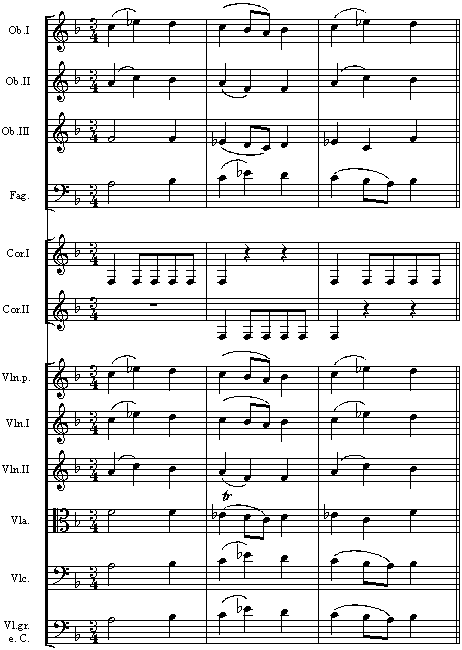
Example 26-3.
<<<.C
>V1' 6"[5(C5!.IXU<>6.]5*&C5=;GXU<K
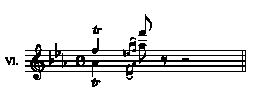
Example 26-4.
.C
>V1' "D--Z&=HIJ?-V<K

Example 26-5.
(print)
<<<.C
>FL1' M<K
>FL2' M<K
>O1' >P' MOLTO CR'> *.&<K
>O2' >P' MOLTO CR'> ")<K
(braille)
>O21' >P'MOLTO CR'> ")*#<K

Example 26-6.
#D%.C
>CL21'** >P;B<":'D<N<>>P'<.O@CEXV<K
>IN ;F>
>HN2' %"GXVU<K
>IN ;E>
>HN43' >P'288_H"DF8HXU<>.DXVU<K
>SEHR ZART U' AUSDRUCKSV'>
>V1'#D% ;B"WFH>C_W'YZ^2<K
>V2'#D% _JXVU<K
>VL'#D% >SEHR ZART> >P;B_$@C"
_&%^)YZ>C_FED^2;BG<K
>VC'#D% >ZART^RQ<K
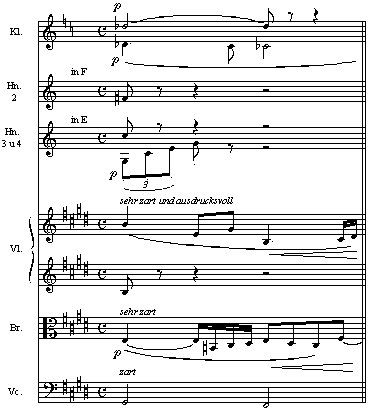
Example 26-7.
.C
>VL' "(*G%DE&GDE&GEF>F"(%G*GE
>F' NICHT GE-
>DB' _R'>F_\
>VL' "FXVU<K
BUNDEN ABER SEHR GEHALTEN>
>DB' _R@CHFGH<K
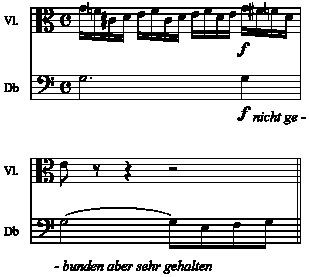
26.24. (In the following, the staves for PC' , FL21' , CYM' , TRI' , and H' are given in the print, each containing one measure rest.)
Example 26-8.
,SEHR MASSIG BEWEGT4 #D4
>O'CL'HN' SEHR GEHALTEN>
>O21' >ZU #B> >F.N"\'H<K
>cl21'%% >in ;b> >ZU #B> >F.O"['I<K
>B21' >F_P+?'+"D+<K
>HN21' >IN ;F> >F"R9\'9J+<K
>HN43' >IN ;F> >F_R"+":'0H+<K
>TP21' >IN ;F> >F_R-W'+J+<K
>TP3' >IN ;C> >F_RU<K
>TB'BTU' >SEHR GEHALTEN>
>TB21' >F"P+_\'#"D+<K
>TB3' >F_N'W@C<K
>BTU' >F^N'W@C<K
>DR' >IN ;C ;U ;G> >F'6_?DXU<K
>V1' >F_\0#VU<K
>V2' >F_\0#VU<K
>VL' >F_?9+-V$0+V<K
>SEHR KR>FTIG>
>VC' >F^N'-" >SEHR KR>FTIG> ^W@C<K
>DB' >F_N'W@C<K
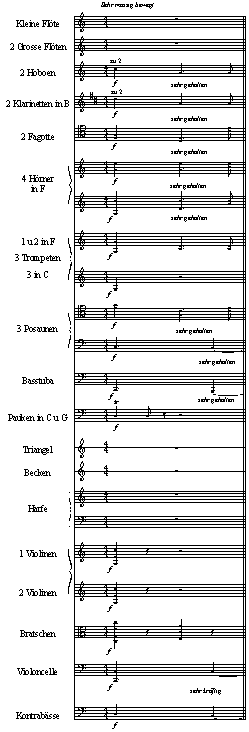
Example 26-9.
#D%.C
#AJA
>CL2' %_P%R
>B1'#D% ;B_S*?'I
>V1'#D% X>D;B.8.D@C2DIH^2]'C>4"F
>VL'#D% >D;B"DIGF>C_E^2;B%F2GI%J^2
>VC'#D% ^QCS
#AJB
>FL1'#D% X>P>D;B.8;D@C2DIHG^2>4'XV<K
>O1'#D% U>P>C;B.]'F<K
>CL2' _T>C":%:<K
>B1'#D% "$E^2XU<K
>V1'#D% >C;B"$E'Y%WD^2>P"I@C<K
>V2'#D% X>D;B.8.D@C2DIH^2>C"]'CF<K
>VL'#D% >D;B"DIGF>C_EF2%FGI^2<K
>VC'#D% ^QCSC<K
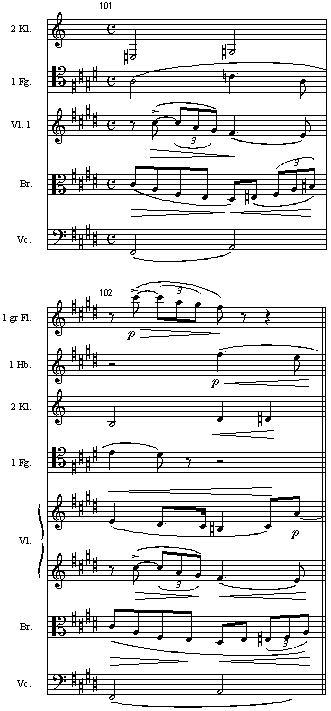
The Transcription of Band and Orchestral Parts
26.25. The transcription of separate orchestral parts should be based on the directions given in Section 23. These will, in general, be found adequate for wind and percussion instruments as well as for strings. The single-line format is used for such parts (as well as for solos for a band or orchestral instrument). The music is divided into segments (based on the structure and phrasing of the composition), generally consisting of from two to four lines of braille. Each segment is introduced at the margin by the appropriate measure number, preceded by the numeral sign. Successive lines in each segment are indented two spaces.
26.26. (11-97) In music for the harp or other plucked instruments, when arrows appear in print to indicate up or down direction for arpeggiation, the arpeggio signs from Table 18 are used as in the next two examples.
Example 26.26-1.
<#F8
>FF'>GLISSANDO>
.>'>KK.G+*9%3>KG+93>KKG+93"
">K.G+93">KK7">K7<K
_>'%_H*+93>KH+937">KH+9377<K
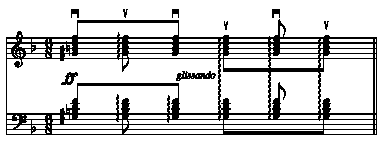
Example 26.26-2.
#F8
_I>KK.F+9-7_F>KK.F#%0/#7 #C4 _["
 etc.
etc.
26.27. (11-97) In the next example a directional arrow indicates 1/4 step alteration of pitch (explained by the composer in the text). In braille, a sharp sign preceded by dot 4, represents the arrow by showing the 1/4 step upward movement of the pitch (Table 5).
Example 26.27-1.
#D4
.(5%GH'@C\@C(^2;B5%GH'@C(@A@%H'@A<K

26.28. (11-97) Brackets are placed where they appear in print. When the print does not provide a specific right-angle line to show the beginning or ending of a bracket, the General Table shows signs for brackets "with unclear ending". These are used in facsimile transcriptions. In non-facsimile transcription, the standard bracket opening or closing signs are used.
Example 26.28-1.
%%.C
;1;ZFGF Z.IGFZ"I"'GF<K

26.29. Print music for non-melodic percussion instruments is written on a staff, a single line, or a partial staff (less than five lines). When written on a full staff, the clef sign (if given) is a bass clef, but often there is no clef sign or a pseudo-sign is in the space allotted for clef signs. (See Example 26.33-1.)
26.30. The instrument to be played is designated by a specific pitch. In some compositions the print gives a list of notes with corresponding instruments (see Example 26.33-1); in other compositions the performer makes this determination from the music itself (see Example 26.32-1).
26.31. In braille, notes written on a full staff are transcribed as if written in the bass clef. Notes written on a single line are brailled as the note C. When a partial staff is used, pitches are assigned by the transcriber who includes a transcriber's note showing pitches with instruments.
Example 26.31-1.
.C
>TRI' 6Y ???? ?VYYYYDD<K

26.32. In percussion music, the braille signs for right and left hand (Table 19) follow the notes.
Example 26.32-1.
7#E ,TEMPLE ,BLOCKS7
#D4
#A V>FF_(AHLHAHL(LMX&MX<>VV_&AFFF"
_YDDD 6.8^['22YLDADL!AIIYDD"
>SF>C^!IIYDD<K

26.33. In print, pictorial symbols are often included that indicate such details as types of sticks or mallets to be used, portion of drum or cymbal to strike, use of snares, etc. In braille, abbreviations represent the pictorial symbols. The abbreviations are inserted in the music at the proper location and are listed in a transcriber's note with a description of the pictorial symbol.
Example 26.33-1.
,L[ SUSP5D$ ,CYMBAL 7;,X-%APE7 "" ,'^J
,HI< SUSP5D$ ,CYMBAL 7;,X-%APE7 ,'_G
REV]SE 5D ( RATTAN /ICKS """""" ,'>RRS
BRU%ES """"""""""""""""""""""""" ,'>BR
REV]SE 5D ( BRU%ES 7METAL7 """" ,'>RBR
ON DOME ( CYMBAL """"""""""""""" ,'>DC
ON C5T] ( CYMBAL """"""""""""""" ,'>CC
ON $GE ( CYMBAL """""""""""""""" ,'>EC
#EG #C4 >EC>P^J@CXV>RRS'V #B4 V"
>DC>PP'2_Q>CC^)>DC_Q>CC^)@C>SIM'"
2^T)_Q^T_Q@C #C8 2_Q=Q.8^)@CJ@C>BR'X<K

 reverse end of rattan sticks
reverse end of rattan sticks  on dome of cymbal
on dome of cymbal
 brushes
brushes  on center of cymbal
on center of cymbal
 reverse end of brushes (metal)
reverse end of brushes (metal)  on edge of cymbal
on edge of cymbal

26.34. When alternate sets of hand signs are given for percussion, they may be transcribed as in-accords or brailled the same as two sets of fingering signs in keyboard music.
Example 26.34-1.
?L?A?L?A<>?A?L?A?L
?LA?AL?LA?AL |
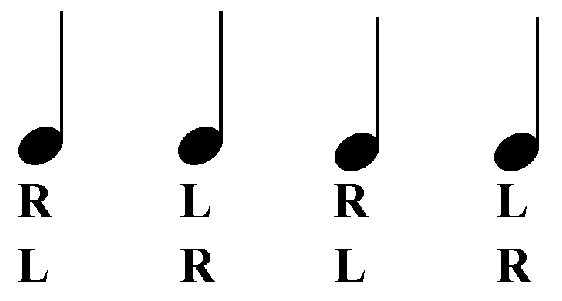 |
26.35. The measure repeat is often indicated in print instrumental parts by an oblique line with dots above and below it. This can be represented in braille by the measure or part-measure repeat given in Table 16.
26.36. It sometimes happens, however, that a print repeat will contain expression marks differing from those in the original measure. When these occur at the commencement of the repeated measure they can be treated as shown in Example 16.16-7, but if they occur at any other point in the repeated measure, that measure must be written in full.
26.37. When the score is printed with reference letters or numbers, they should form the basis of the paragraphing in separate band parts.
26.38. The print should be reproduced exactly as it stands (save for the exceptions mentioned above) and the transcriber must devise special signs to meet special cases, and must give adequate explanations of these in the braille text.
26.39. The signs in Table 19 (B) are used to represent print devices that occur primarily in jazz band music. Bowing signs, to give direction, are combined either with the simple slur or with the glissando. (The slur or glissando sign remains closest to the note, preceded or followed by the directional signs. This is an exception to Par. 22.38 with respect to closeness of bowing signs to notes.) The slur and glissando signs, as used here, must be considered integral parts of compound signs. Another device which indicates a dip in pitch may be shown in braille by using the "pedal down" sign before the "dipped" note. Because of the infrequency and uniqueness of these indications, these signs should be explained in a transcriber's note. The following example contains other possible combinations of directional and slur or glissando signs applicable to jazz notation.
Example 26.39-1.
<'C.? 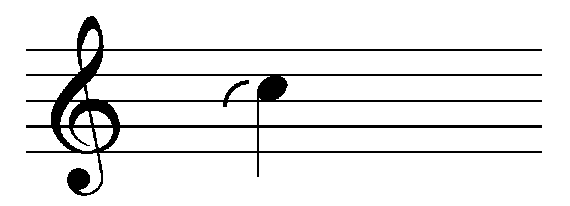
<'@A.? 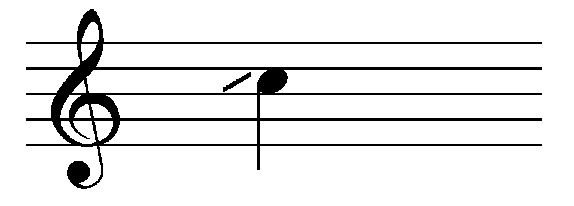
.?C<B 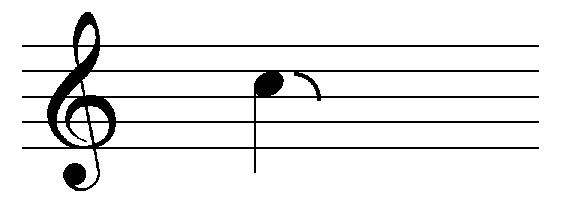
.?@A<B 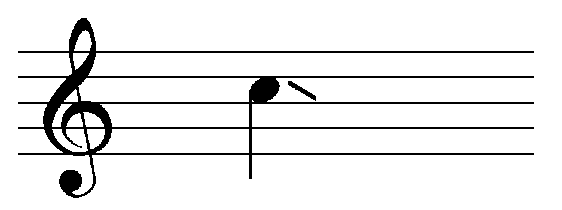
<C.? 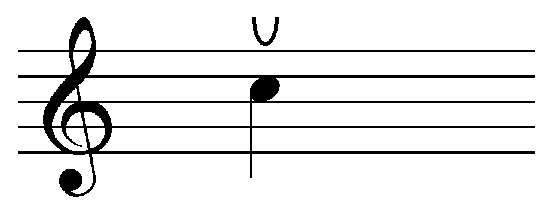
26.40. In the transcription of a single part from a band, orchestral or ensemble work, short cues of three to four bars should be written in where there are long rests. Such cues are written as in-accords after the measure rest representing the solo part. Only notes, rests and ties are necessary in the cued part.









 etc.
etc.




 reverse end of rattan sticks
reverse end of rattan sticks  on dome of cymbal
on dome of cymbal  brushes
brushes  on center of cymbal
on center of cymbal  reverse end of brushes (metal)
reverse end of brushes (metal)  on edge of cymbal
on edge of cymbal 





